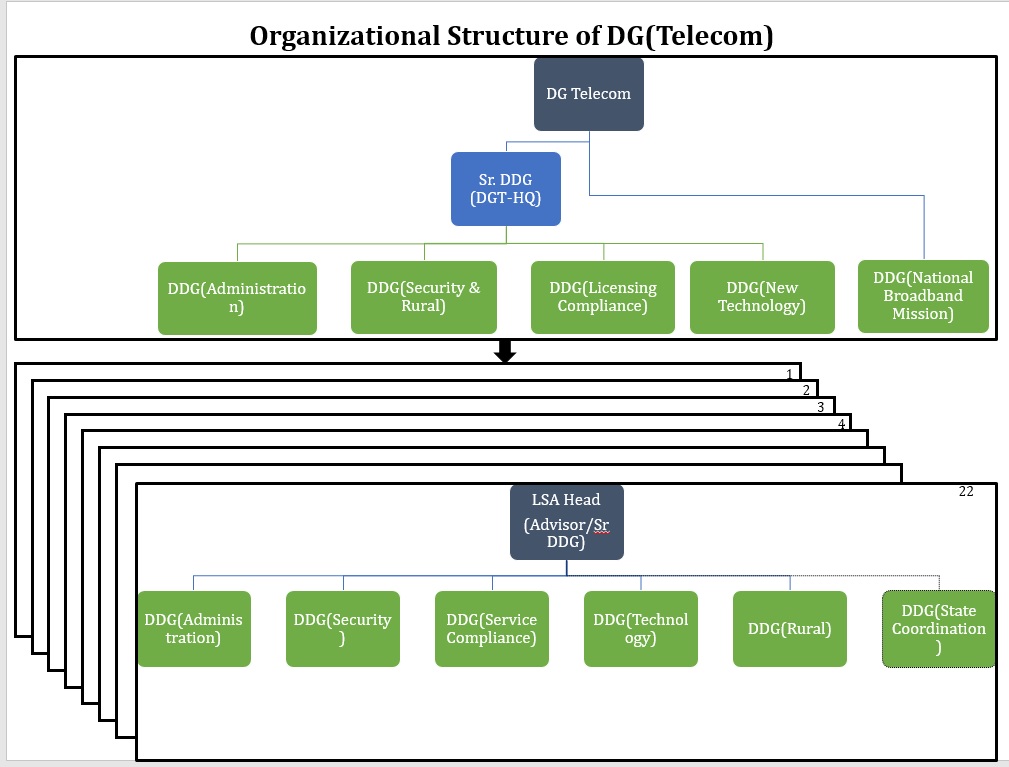Director General Telecom
About Us
Director General Telecom is an apex level officer and acting as head of the DoT field units in all the 22 Licensed Service Areas located across the country. Headquarter of Director General Telecom (DGT-HQ) is located in Delhi. Director General Telecom (DGT) is supported by a team consisting of one Senior Deputy Director General and four Deputy Director General at headquarter.
DG Telecom Setup

Work Allocation of Deputy Director Generals at DGT-HQ
Security
- Agencies and Telecom Service Providers
- Operation and Maintenance of CMS/ IMS
- Curbing illegal activities/ Control over clandestine / illegal operation of telecom networks
- To file FIR against culprits, issue notices indicating violation of conditions of various Acts in force
- Analysis of call/subscription/traffic data of various licensees
- Security related Inspection of Internet Lease Line, International/ National Private Leased Circuit
- Detection and Analysis of Non-genuine IMEI cases
- Security Audit of Telecom Network of Service Provider
- Advocacy and Public Awareness on related matters
Technology
- Inspections of Telecom Service Providers [Access Service, NLD, ILD, ISP, OSP, IP, VSAT, etc. )
- OSP Registrations.
- Telecommunication services in response to Disaster (Disaster Management)
- Assistance in natural calamities or emergency situations.
- Verification of VLR data
- Matters related to NOC for selling of the global calling cards, international SIMs etc.
- Ascertaining that the licensee is providing the services within permitted area Time synchronization of Telecom Networks
- Secured Dedicated Communication Network
- Interconnect Exchange
- Advocacy and Public Awareness on related matters
Service Compliance
- Checking of the service compliance by the licensee in respect of the license conditions and any directions issued by the licensor in public interest.
- Matters related to Electro Magnetic Radiation (EMR) emission from Telecom installations & Tarang Sanchar Portal
- Subscriber Document Verification with the objective to ascertain whether the mobile service operators are following the DoT guidelines for Subscriber verification before providing connections
- Service Testing of various Licensed Service Providers in the Licence area and checking roll-out obligation as per license condition
- Issues related to Mobile Number Portability
- Advocacy and Public Awareness on related matters
Administration
- Grievance redressal of subscribers in respect of deficiency by various operators and interaction on social media.
- Responding RTI queries.
- Training & Skill Development
- Holding of workshops, conferences and presentations
- Responding to Parliamentary matters
- Handling Court cases
- Other regular administrative works
- Advocacy and Public Awareness on related matters
Rural
- Right of Way (RoW) related issues and coordination with State Governments.
- Network coverage/connectivity of villages for Direct Benefit Transfer (DBT) mission and of Banks in rural areas under Financial Inclusion Planning (FIP)
- Inspection of LWE & USOF sites for technical compliance being funded by DoT
- Implementation of Environmental sustainable Technologies in rural areas
- Advocacy and Public Awareness on related matters
Background Information
With the increasing number of telecom operators in the country, the Government felt the need for presence of Telegraph Authority in the field at all the Licence Service Areas (LSA) and Large Telecom Districts of the country, in order to ensure that service providers adhere to the licence conditions and for taking care of telecom network security issues. With the growth of private telecom and internet services, an increase in illegal / clandestine telecom operations was also observed. To address these issues, the Government created initially four Vigilance Telecom Monitoring cells (VTM) in Nov.2004 at Delhi, Mumbai, Hyderabad and Chennai.
Nine more VTM Cells were created during the 2006 for the circles of Punjab, Rajasthan, Gujarat, Kerala, Karnataka, Maharashtra, Tamil Nadu, West Bengal and UP (E) and fifteen VTM Cells were subsequently added in Jan 2007 for Andhra Pradesh, Bihar, Madhya Pradesh, Haryana, UP (West), Andaman & Nicobar, Assam, Chhattisgarh, Union Territory of Jammu & Kashmir, Union Territory of Ladakh, Jharkhand, Himachal Pradesh, North East-I, North East-II, Odisha and Uttarakhand. Six more VTM Cells were added in March, 2007 for Kolkata, Ahmedabad, Bengaluru, Pune, Jaipur and Lucknow, taking the total number of VTM Cells to 34.
Since formation of Vigilance & Telecom Monitoring (VTM) Cells in the DOT, the role and functions of VTM Cells have increased manifold. With a view to reflect the entire gamut of functions assigned to the Cells and to distinguish their role vis--vis staff-vigilance activities, the name of VTM Cells was changed to Telecom Enforcement, Resource and Monitoring (TERM) Cells with effect from 5th August 2008. After further enrichment to the roles and functions of these units, these field units are now referred as DoT LSA Units.
In May 2013, three new units namely Security, New Technology and PG were also created along with existing TERM cells to cater to the various functions in the Field.
In Feb 2017, a unified structure of Field units including TERM, Security, PG and NT was created in each LSA and an Apex level post of Director General Telecom has been created as Head of all the 22 LSA Units spread all over the country.
Important Information
- Charter of Duties of DoT Field Units
- Administrative Audit of LSA - OM dated 11072022 and Questionnaire for Audit
- Contacts of CPIOs & FAAs in DGT HQ & DoT LSA Units
- Guidelines for forwarding proposals/referring the issues to DGT Office
- Nodal Officer details for handling Public Grievances in LSAs
- A Journey for EMF








 दूरसंचार विभाग
दूरसंचार विभाग




